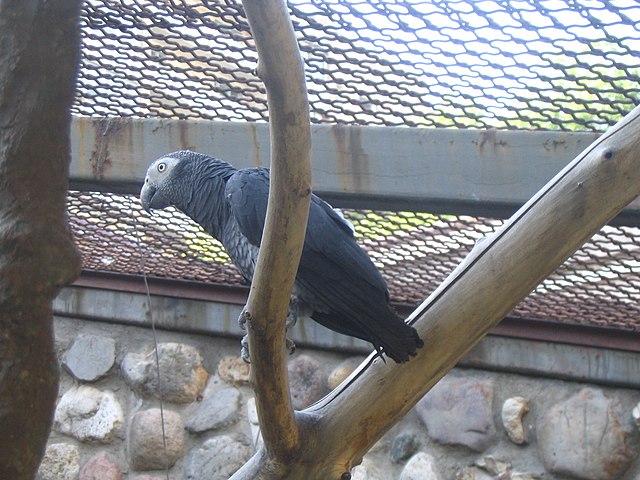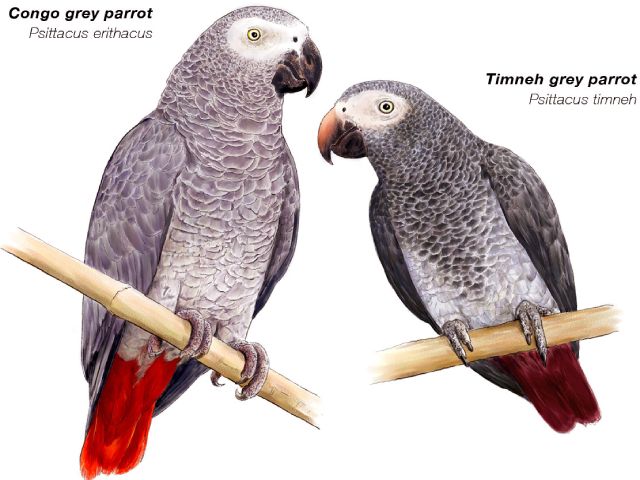The Timneh African Grey, scientifically known as psittacus erithacus timneh, is one of two recognized subspecies of African Grey (along with the congo – psittacus erithacus erithacus). The two subspecies are physically differentiated by the timneh’s darker grey coloring, smaller stature, partially horn-colored upper mandible, and maroon-colored tail feathers. The Timneh African Grey is a beautiful parrot – even without all the flashiness.
The Timneh occupies a range in Africa that extends from Guinea to the Ivory Coast and is separated from the much larger and more diverse territory of the Congo African Grey. Due to habitat destruction and the pet trade, the Timneh African Grey and Congo African Grey were uplisted as vulnerable in the IUCN Red List of Threatened Species in 2012. While it is reported that this species’ numbers in the wild populations can withstand legal trade, authorities have failed to stop those who disguise the actual numbers of birds being trapped and exported illegally. As a result, numbers in the wild are dwindling.

The Timneh African Grey is between 9 and 11 inches in length and weighs approximately 275-375 grams; these figures can vary somewhat from bird to bird.
The life span of a Timneh African Grey can be between 40-60 years. Reaching sexual maturity around age three, they are monogamous and can breed as often as three times a year depending on the pair. During the breeding season, they lay 2 to 4 eggs every two to three days. The young hatch at 28-30 days and are independent at 12 to 14 weeks.
Timnehs have a long history of being kept as pets and companions. It is said that the ancient Egyptians, Greeks, and even King Henry VIII of England had African Greys as pets. This long history in human society is likely due to their incredible intelligence. They are able to mimic a wide variety of sounds and manage extensive vocabularies. In addition to the ability to put labels on the things in their environment, many African Greys have been known to assign appropriate adjectives to the words they learn – such as a big ball or cold apple.
In captivity, they are extremely social birds and develop a strong bond with their owners and many enjoy a little snuggling and petting by their owners. They do not normally get along with many other species but are great apartment pets because they are not normally very loud. They do require a significant amount of time each day interacting with their owner outside of their cage.
Bonds of trust can be developed with several people as timnehs are not necessarily one-person birds. They’ll love and bond with anyone who spends time with them. Socializing your bird will help to create the stress-free environment that it needs to thrive. Behavior issues, such as biting and plucking are common with the African grey species and are best avoided with appropriate care and training.
What is the difference between Timneh and Congo Grey Parrots?

African Grey parrots come in two distinct sub-species, the Congo African Grey and the Timneh African Grey. The Timneh African grey is the smaller of the two species which grows to about 10 inches in length.
Both have grey feathers, hence the name, but the Timneh often lacks the vivid scarlet under-feathers on the tail that adorns the Congo and instead often has dark maroon or even tail feathers which makes them slightly less popular.
Their beaks are distinctive in adulthood with an orange-ish coloring in the center of the upper mandible with the rest of the beak being black. So are they a Nervous Nellie or a Loving and Loyal Parrot? Both. The Timneh is considered an extremely sensitive bird, second only to the Cockatoo.
Feather Plucking in Timneh Parrots
This means that owners must spend a lot of time and attention on their Timneh.
The Timneh African Grey parrot isn’t generally fond of snuggling and petting, unlike the cockatoo. This incredible sensitivity to changes in their environment and a general fearfulness leads them to be chronic feather pluckers.
Feather plucking can be a real problem for Timneh grey parrot owners and can be avoided with proper attention, training, and care to provide an optimal environment. Check this out for more information on stopping your timneh’s feather plucking or to get information on more Timneh African Grey common problems.
Timneh African Greys are extremely intelligent. They can learn tricks and are excellent mimickers and some are able to understand language in context – you can talk with your Timneh and they will understand it.
Of course, this level of language skill takes time to learn, and not all African Greys will learn to talk. This intelligence also means that if you don’t take the time to train them and teach them the rules of your home, they can become little terrors. Nipping is common. The good news is that they are not particularly noisy birds so you won’t tick off your neighbor.
So where exactly does the Timneh come from? Africa is a huge continent. The Timneh is native to western parts of the moist Upper Guinea forests and bordering savannas of West Africa from Guinea-Bissau, Sierra Leone, and Southern Mali east to Côte d’Ivoire.
Known for their quiet and non-aggressive nature, Timneh’s are extremely social birds that crave a bond with their owners. When this bond is formed, it is usually quite strong and a change of ownership or being re-homed will cause an abundance of health and behavior problems with these sensitive creatures.
Because they can live up to 50 years in captivity, acquiring a Timneh shouldn’t be taken lightly. They require a special diet, plenty of attention, and training, and their size and intelligence mean they will need plenty of space to explore and toys to play with in a comfortable environment. Check this out for more information on a well-balanced diet and the right cage size.
Their loyalty and tendency to be easily frightened or stressed out means that they’re generally not good as a member of a multi-bird household. They don’t generally get along with other birds, though exceptions are known to happen. They probably aren’t good companions for homes with many pets and children are better for quieter, less spontaneous environments.
The ideal owner will have an abundance of time to spend with their timneh parrot, including time to train them, play with them, and simply hang out. Timnehs are too smart to just sit in their cage all day.
This is why trick training is absolutely necessary to keep your timnehs mind stimulated constantly. As an ideal owner, you will need to make sure your Timneh’s diet is complete, they get plenty of sleep, and they’re provided an enriched environment – plenty of toys – when you’re away. The Timneh is an ideal companion bird for the right owner.
